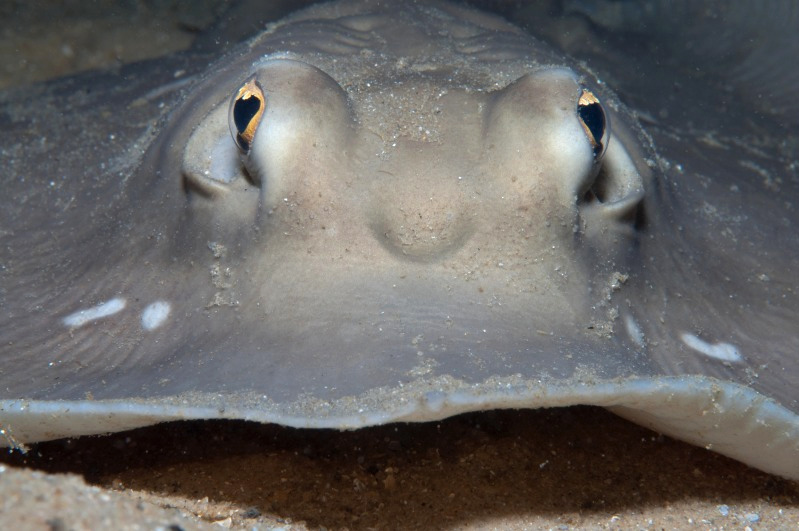- Classification
- CHONDRICHTHYES
- MYLIOBATIFORMES
- UROLOPHIDAE
- Urolophus
- paucimaculatus
Sparsely-spotted Stingaree, Urolophus paucimaculatus Dixon 1969

Head of a Sparsely-spotted Stingaree, Urolophus paucimaculatus, at St Leonards in Port Phillip Bay, Victoria. Source: Julian K. Finn / Museum Victoria. License: CC by Attribution
A pale grey stingaree with distinctive whitish spots on the disc. the spots are arranged in a regular pattern, and each has a darker margin. The Sparsely-spotted Stingaree is widely distributed and abundant on sandy bottoms and in seagrass beds in southern Australia.
While this species is most similar to the Common Stingaree, Trygonoptera testacea, it lacks the dark mask around the eyes.
Stingarees must handled with great care as the serrated spine is venomous and can inflict a very painful wound.
Sparsely-spotted Stingaree, Urolophus paucimaculatus Dixon 1969
More Info
|
Distribution |
Endemic to southern Australia, from from northern New South Wales to about Lancelin in Western Australia, including Victoria, Tasmania and South Australia. Sparsely-spotted stingarees are common and abundant on sandy bottoms and in seagrass beds in shallow bays, harbours and inlets, and on the continental shelf to a depth of 150 m. |
|
Features |
Disc smooth, somewhat rhomboidal in shape with a broadly triangular fleshy snout. Tail long, flattened near base, with prominent skin folds along the sides; caudal fin deepish, spine long and slender; dorsal fin absent. |
|
Size |
To 57 cm. |
|
Colour |
Pale grey above with a variable number of distinctive pale, regularly-arranged spots, each with a darker border. Underside pale. |
|
Feeding |
Carnivore - prey on crustaceans, polychaete worms and small fishes. Juveniles feed on small crustaceans. |
|
Biology |
Mating occurs in early to mid-summer and females give birth to a maximum of 6 pups in late autumn after a gestation of 10-12 months. |
|
Fisheries |
Commonly taken as bycatch in seine and trawl fisheries in southern Australia, although seldom marketed. |
|
Similar Species |
While this species is most similar to the Common Stingaree, Trygonoptera testacea, it lacks the dark mask around the eyes. |
|
Species Citation |
Urolophus paucimaculatus Dixon, 1969, Vic. Nat. 86(1): 11, pls 1-3. Type locality: off Cape Patton, Victoria. |
|
Author |
Bray, D.J. 2018 |
Sparsely-spotted Stingaree, Urolophus paucimaculatus Dixon 1969
References
Dixon, J.M. 1969. A new species of ray of the genusUrolophus (Elasmobranchii : Urolophidae) from Victoria. Victorian Naturalist 86(1): 11-18 pls 1-3
Edwards, R.R.C. 1980. Aspects of the population dynamics and ecology of the white spotted stingaree, Urolophus paucimaculatus Dixon, in Port Phillip Bay, Victoria. Australian Journal of Marine and Freshwater Research 31: 459-467
Gomon, M.F., Yearsley, G.K. & Last, P.R. 2008. Family Urolophidae. 125-137 pp. in Gomon. M.F., Bray, D.J. & Kuiter, R.H (eds). Fishes of Australia's Southern Coast. Sydney : Reed New Holland 928 pp.
Hobday, D.K., Officer, R.A. & Parry, G.D. 1999. Changes in demersal fish communities in Port Phillip Bay, Australia, over two decades, 1970–91. Marine and Freshwater Research 50: 397–407.
Hutchins, J.B. & Swainston, R. 1986. Sea Fishes of Southern Australia. Complete field guide for anglers and divers. Perth : Swainston Publishing 180 pp.
Last, P.R. & Gomon, M.F. 1994. Family Urolophidae. pp. 172-181 figs 150-159 in Gomon, M.F., Glover, C.J.M. & Kuiter, R.H (eds). The Fishes of Australia's South Coast. Adelaide : State Printer 992 pp. 810 figs
Last, P.R. & Stevens, J.D. 1994. Sharks and Rays of Australia. Canberra : CSIRO Australia 513 pp. 84 pls
Last, P.R. & Stevens, J.D. 2009. Sharks and Rays of Australia. Collingwood : CSIRO Publishing Australia 2, 550 pp.
Last, P.R., Yearsley, G.K. & White, W.T. 2016. Family Urolophidae pp. 676-705. In: Last, P.R., White, W.T., de Carvalho, M.R., Séret, B., Stehmann, M.F.W. & & Naylor, G.J.P. (eds) Rays of the World. Melbourne: CSIRO Publishing, 800 pp.
Platell, M.E., Potter, I.C. & Clarke, K.R. 1998. Resource partitioning by four species of elasmobranchs (Batoidea: Urolophidae) in coastal waters of temperate Australia. Marine Biology 131(4): 719-734.
Trinnae, F.I. 2013. Reproduction in five sympatric batoid species (Family Urolophidae) from south-eastern Australia. PhD Thesis, Deakin University, 198 pp.
Trinnie, F.I., White, W.T. & Walker, T.I. 2006. Urolophus paucimaculatus. The IUCN Red List of Threatened Species 2006: e.T60102A12300571. http://dx.doi.org/10.2305/IUCN.UK.2006.RLTS.T60102A12300571.en. Downloaded on 17 November 2016.
White, W.T. & Potter, I.C. 2005. Reproductive biology, size and age compositions and growth of the batoid Urolophus paucimaculatus, including comparisons with other species of Urolophidae. Marine and Freshwater Research 56(1): 101-110








